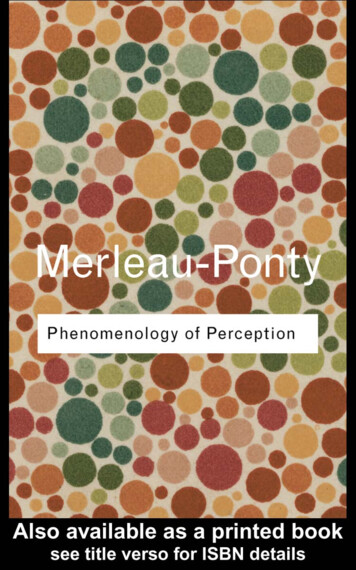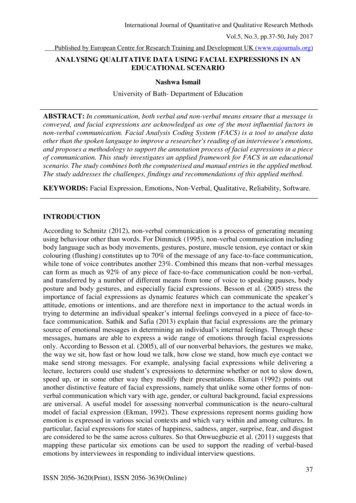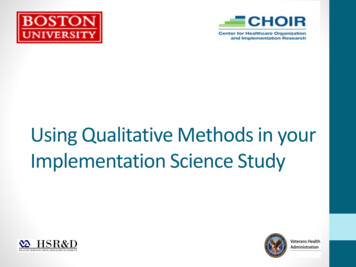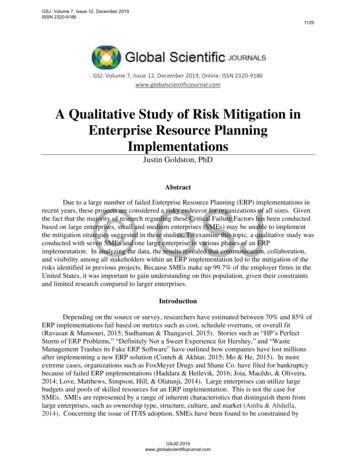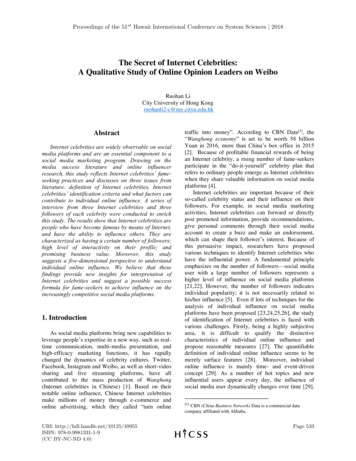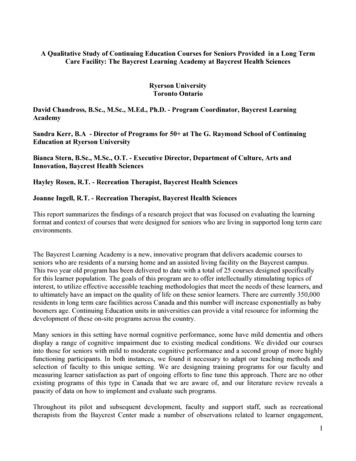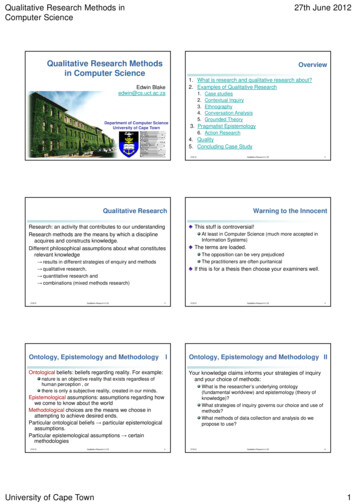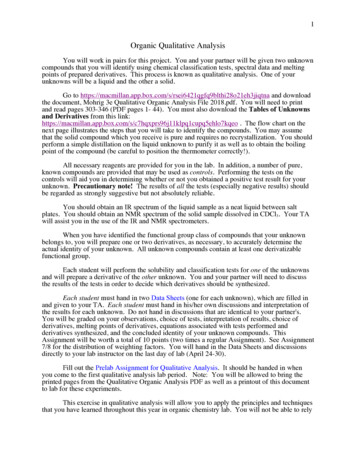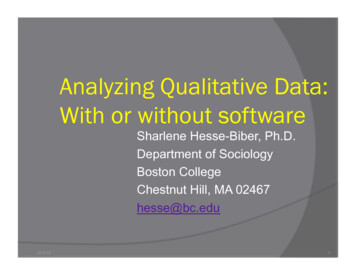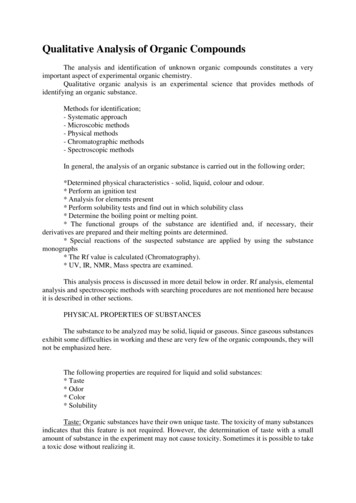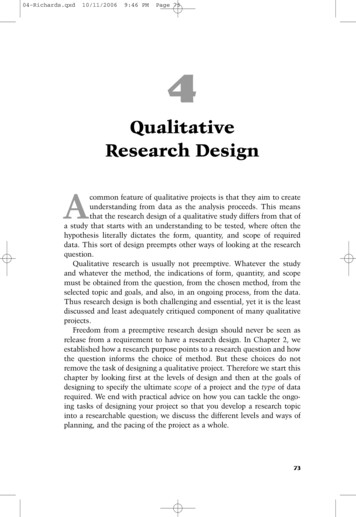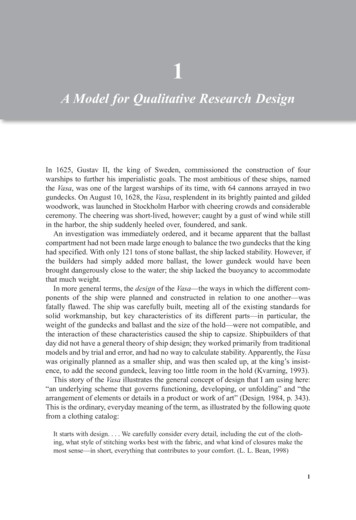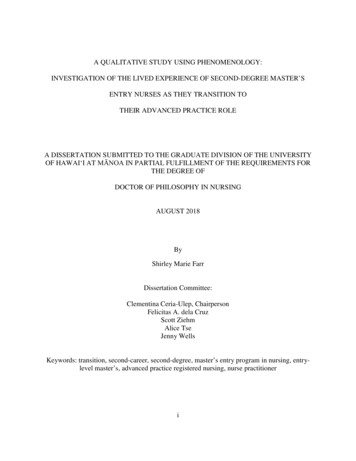
Transcription
A QUALITATIVE STUDY USING PHENOMENOLOGY:INVESTIGATION OF THE LIVED EXPERIENCE OF SECOND-DEGREE MASTER’SENTRY NURSES AS THEY TRANSITION TOTHEIR ADVANCED PRACTICE ROLEA DISSERTATION SUBMITTED TO THE GRADUATE DIVISION OF THE UNIVERSITYOF HAWAI‘I AT MĀNOA IN PARTIAL FULFILLMENT OF THE REQUIREMENTS FORTHE DEGREE OFDOCTOR OF PHILOSOPHY IN NURSINGAUGUST 2018ByShirley Marie FarrDissertation Committee:Clementina Ceria-Ulep, ChairpersonFelicitas A. dela CruzScott ZiehmAlice TseJenny WellsKeywords: transition, second-career, second-degree, master’s entry program in nursing, entrylevel master’s, advanced practice registered nursing, nurse practitioneri
DEDICATIONI would like to dedicate this paper to my family. My three children, Drew, Amanda, andRebekah: you have always been my inspiration and my true blessing in life. You continue toamaze me in all that you do. My additional children, Allison and Jeff, thank you for loving mychildren and being their perfect spouses. My beautiful grandchildren, Luke, Anna, and Hannah(and those yet to come), being able to see the world through your eyes has made me appreciatethe important things in life. My parents, Beverley and Donald, thank you for always believing inme. My sister Barbara and brother Neil, and their families, thank you for realizing that as the“big sister” I am always right. To my extended family, thank you for keeping me sane all theseyears with laughter, love, good food, and friendship. Lastly, Dr. Vellore Muraligopal, myfavorite Neonatologist, who inspired me to continue my education and who always reminded methat asking questions and increasing self-knowledge are never wasted.ii
ACKNOWLEDGMENTSI would like to acknowledge and express my sincerest gratitude to Dr. Clementina CeriaUlep, chairperson, and the members of my dissertation committee: Dr. Felicitas A. dela Cruz, Dr.Scott Ziehm, Dr. Alice Tse, Dr. Linda Oshita, and Dr. Jenny Wells for their time, guidance, andsupport throughout this experience. My knowledge development during this journey is attributedto your willingness to share your knowledge and expertise. I would also like to acknowledge thesupport from Dr. Sandra LeVasseur, Aeza Hafalia, James Callahan, and Dr. Ray Jarman.I would like to acknowledge Dr. Afaf Meleis, for her transition theory and for herpermission to use it for my study.I would also like to acknowledge my appreciation of support from the faculty, staff, andthe second-career students at Azusa Pacific University, School of Nursing, Azusa, California.Lastly, I would like to acknowledge the participants; without their stories, thisdissertation would not have an ending.iii
ABSTRACTSignificance: Transition to advanced practice can be a challenge for students who are successfulclinical bedside nurses. Second-career master’s entry students experience several transitionswithin their nursing educational process. Investigating the process that they go through the first 2years after completing their graduate education and becoming Advanced Practice RegisteredNurses (APRNs) was valuable in understanding the consequences/outcomes of their transition asit relates to role performance, clinical competence/judgment, professional competence, andsatisfaction. Transition occurs throughout the stages in life. Transition is as an evolving processrelated to multiple situations in life experiences.Purpose: The purpose of this study was to investigate the lived experience of the second careermasters’ entry nurse as he or she transitions in the APRN role as a Nurse Practitioner (NP).Method: The study design was qualitative, exploratory, and involved in-depth focus groupinterviews using a phenomenological method of inquiry. The sample was purposeful, withrecruitment from Azusa Pacific University’s second-career Entry-Level Master’s program. Theselected participants have graduated from their nursing program and have been working as NPsin an outpatient clinical setting from 1 to 24 months.Results: Seven main themes emerged from the focus group discussions: feeling overwhelmed,gaining confidence, being humble, being a life-long learner/educator, weaving previous degreeand life experience, recognizing gaps and challenges in APRN education, and practicing in afamiliar environment to ease the transition.Conclusions and Implications: Participants were able to transition to their NP role within thefirst 12 months. Implications for further research include the need to compare different entry-iv
level master’s nursing programs that have an NP focus, examine traditional Master of ScienceNPs, and expand the timeframe to 3 to 5 years in practice.v
TABLE OF CONTENTSAcknowledgments. iiiAbstract . ivList of Tables .xList of Figures . xiList of Abbreviations . xiiChapter 1: Introduction .1Background .2Statement of the Problem .3Significance of the Study .3Purpose of Study .3Definitions of Key Terminology.4Second-Career Nurse .4Master’s Entry Program in Nursing .4Advanced Practice Registered Nurse .4Nurse Practitioner .5Chapter 2: Literature Review .7Introduction .7Second-Career Nurse .7Advanced Practice Registered Nurse .12Nurse Practitioners .13Conceptual Framework .16Types of Transitions .18vi
Developmental Transitions .19Situational Transitions .19Health/Illness Transitions .19Organizational Transitions .20Properties of Transitions .20Awareness .22Engagement.21Time Span .22Critical Points.22Healthy Transitions .22Confidence .23Mastery .23Connected .23Coping .24Reflection .24Application.24Summary .25Chapter 3: Methodology .26Introduction .26Research Design.27Phenomenology.28Sample.29Research Questions .30vii
Question Development.31Protection of Human Subjects .32Data Collection .32Conduct of Focus Groups .32Data Protection.35Demographic Information.35Validity .35Trustworthiness in Qualitative Research .35Credibility .36Transferability .37Dependability .37Confirmability .37Limitations .38Application.38Summary .39Chapter 4: Research Findings .40Demographic Characteristics .40Emergent Themes .42Theme 1: Feeling Overwhelmed .42Theme 2: Gaining Confidence .43Theme 3: Being Humble .45Theme 4: Being a Lifelong Learner and Educator.45Theme 5: Weaving Previous Degree and Life Experiences intoviii
Current Practice .46Theme 6: Recognizing Gaps or Challenges in Advanced Practice Education . 48Theme 7: Practicing as an NP in a Familiar Environment to Ease Transition .51Summary .53Chapter 5: Discussion .54Feeling Overwhelmed .54Gaining Confidence .55Being Humble .55Being a Lifelong Learner and Educator .56Weaving of Previous Degree and Life Experiences in Practice .56Recognizing Gaps or Challenges in Advance Practice Education.57Practicing as an NP in a Familiar Environment to Ease Transition.57Strengths and Limitations .58Significance to Nursing and Education.59Implications for Further Research .59Final Thoughts .60Appendix A: Focus Group Interview Guide .61Appendix B: Overview of Interview and Research Questions .62Appendix C: Participant Recruitment Letter .63Appendix D: Informed Consent .64Appendix E: Demographic Questionnaire for Participants .67References .68ix
LIST OF TABLESTable 1: Demographic Characteristics of the Six Study Participants .41x
LIST OF FIGURESFigure 1: Theory of Transition: Types, Properties, and Outcomes of Healthy Transitions.18Figure 2: Feeling Overwhelmed .43Figure 3: Gaining Confidence .44Figure 4: Being Humble.45Figure 5: Being a Lifelong Learner and Educator .46Figure 6: Weaving Previous Degrees and Life Experience into Current Practice .48Figure 7: Gaps or Challenges in NP Education .50Figure 8: Practicing as an NP in a Familiar Environment .52xi
LIST OF ABBREVIATIONSAACNAmerican Association of Colleges of NursingAANPAmerican Association of Nurse PractitionersABSNAccelerated Bachelor of Science in NursingACAAffordable Care ActAPNAdvanced Practice NurseAPRNAdvanced Practice Registered NurseAPUAzusa Pacific UniversityBSNBachelor of Science in NursingCINAHLCumulative Index of Nursing and Allied Health LiteratureCITICollaborative Institutional Training InitiativeCNLClinical Nurse LeaderCNMCertified Nurse MidwifeCNSClinical Nurse SpecialistCRNACertified Registered Nurse AnesthetistCTComputed TomographyDNPDoctor of Nursing PracticeDOPPDomains of Professional PracticeEBSCOElton B. Stephens Co.ELMEntry Level MastersICNInternational Council of NursesIERCInland Empire Regional Centerxii
IOMInstitute of MedicineIPAInterpretative Phenomenological AnalysisIRBInstitutional Review BoardMDDoctor of MedicineMEPNMaster’s Entry Program in NursingMRIMagnetic Resonance ImagingMSNMaster of Science in NursingMSMaster of ScienceNONPFNational Organization of Nurse Practitioner FacultyNPNurse PractitionerOVIDPublius Ovidius NasoPMHNPPsychiatric-Mental Health Nurse PractitionerPPMProfessional Practice ModelRNRegistered NurseRN-NCLEXRegistered Nurse- National Council Licensing ExamSDStandard DeviationSDRCSan Diego Regional CenterTPATissue Plasminogen ActivatorUSUnited Statesxiii
CHAPTER 1. INTRODUCTIONThe aim of this study was to investigate the lived experience of non-nurse entry-levelmaster’s graduates as they transition in their Advanced Practice Registered Nurse (APRN) role.This study is significant in discovering how the entry-level master’s nurse practitioner transitionsin practice. According to the American Association of Colleges of Nursing (AACN, 2014), thereis a projected shortage of Registered Nurses (RNs) in the United States (US). This shortage ofnurses stems from the increasing longevity of the general population. “Compounding theproblem is the fact that nursing schools across the country are struggling to expand capacity tomeet the rising demand for care given the national movement toward healthcare reform”(AACN, para. 1).Likewise, there appears to be a shortage of master’s and doctoral prepared nurses.Master’s education prepares nurses for flexible leadership and critical action within complex,changing systems, including health, educational, and organizational systems. Master’s educationequips nurses with valuable knowledge and skills to lead change, promote health, and elevatecare in various roles and settings. With the changes in the US healthcare system and theinduction of the Affordable Care Act (ACA), there is an increased need for APRNs. Thelandmark study between the Robert Wood Johnson Foundation and the Institute of Medicinereleased in Fall 2010 (Institute of Medicine, 2010) prompted the need for change in nursing. Theappointed committee generated a report that made recommendations to transform the nursingprofession. Through its deliberations, the committee developed four key messages:1. Nurses should practice to the full extent of their education and training.2. Nurses shoul
ABSN Accelerated Bachelor of Science in Nursing ACA Affordable Care Act APN Advanced Practice Nurse APRN Advanced Practice Registered Nurse APU Azusa Pacific University BSN Bachelor of Science in Nursing CINAHL Cumulative Index of Nursing and Allied Health Literature CITI Collaborative Instit
